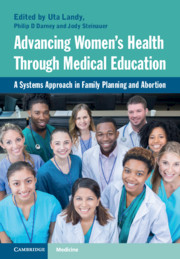 Advancing Women's Health Through Medical Education
Advancing Women's Health Through Medical Education Book contents
- Advancing Women’s Health Through Medical Education
- Reviews
- Advancing Women’s Health Through Medical Education
- Copyright page
- Dedication
- Contents
- Contributors
- Preface
- Acknowledgments
- Introduction
- Section I Abortion Training: Workforce, Leadership, Social & Political Impact
- Chapter 1 A Systems Approach to Medical Education
- Chapter 2 Training in Contraception and Abortion to Reduce Maternal Mortality
- Chapter 3 The History of Integrated Training in Abortion and Contraception for Obstetrician-Gynecologists in the USA
- Chapter 4 The Medical Community, Abortion and the Crucial Role of Physician Advocacy
- Chapter 5 The US Fellowship in Family Planning as a Community of Practice
- Chapter 6 Building Evidence through Research
- Chapter 7 Impact of Integrated Family Planning Training
- Chapter 8 Conscientious Provision and Objection in Medical Training in the Context of the Abortion Controversy
- Section II Integration of Abortion into Graduate Medical Education
- Section III Family Planning Curricular Design & Implementation
- Section IV Reproductive Health Services & Abortion Training: Global Examples
- Index
- References
Chapter 3 - The History of Integrated Training in Abortion and Contraception for Obstetrician-Gynecologists in the USA
from Section I - Abortion Training: Workforce, Leadership, Social & Political Impact
Published online by Cambridge University Press: 30 July 2021
- Advancing Women’s Health Through Medical Education
- Reviews
- Advancing Women’s Health Through Medical Education
- Copyright page
- Dedication
- Contents
- Contributors
- Preface
- Acknowledgments
- Introduction
- Section I Abortion Training: Workforce, Leadership, Social & Political Impact
- Chapter 1 A Systems Approach to Medical Education
- Chapter 2 Training in Contraception and Abortion to Reduce Maternal Mortality
- Chapter 3 The History of Integrated Training in Abortion and Contraception for Obstetrician-Gynecologists in the USA
- Chapter 4 The Medical Community, Abortion and the Crucial Role of Physician Advocacy
- Chapter 5 The US Fellowship in Family Planning as a Community of Practice
- Chapter 6 Building Evidence through Research
- Chapter 7 Impact of Integrated Family Planning Training
- Chapter 8 Conscientious Provision and Objection in Medical Training in the Context of the Abortion Controversy
- Section II Integration of Abortion into Graduate Medical Education
- Section III Family Planning Curricular Design & Implementation
- Section IV Reproductive Health Services & Abortion Training: Global Examples
- Index
- References
Summary
Although academic obstetrician-gynecologists were important advocates for legal abortion, few teaching hospitals became sources of abortion care in the USA. Instead, private clinics provided nearly all abortions and medical students and residents had little opportunity to learn about abortion.Likewise, when contraception was earlier legalized, the major sources became Planned Parenthood and public health department clinics funded through the US Government’s Title X Program.Academic organizations responsible for training obstetrician-gynecologists recognized these deficiencies and moved to require training in family planning and to set standards for it.A few major teaching hospitals provided models for such training.Their efforts were emulated and financially supported at training programs around the USA through the “Ryan Residency Training Program in Abortion and Contraception” reaching one hundred programs over a 20-year effort.Because teaching hospitals largely ignored abortion and their reproductive endocrinologists were busy with IVF, academic training programs failed to develop researchers in abortion and contraception.In response to the need for clinical research and teaching in family planning, post-residency fellowship programs were simultaneously established in 30 medical schools, eventually leading to recognition in 2020 of “Complex Family Planning” as one of the official subspecialties of obstetrics and gynecology.
Keywords
- Type
- Chapter
- Information
- Advancing Women's Health Through Medical EducationA Systems Approach in Family Planning and Abortion, pp. 32 - 47Publisher: Cambridge University PressPrint publication year: 2021
